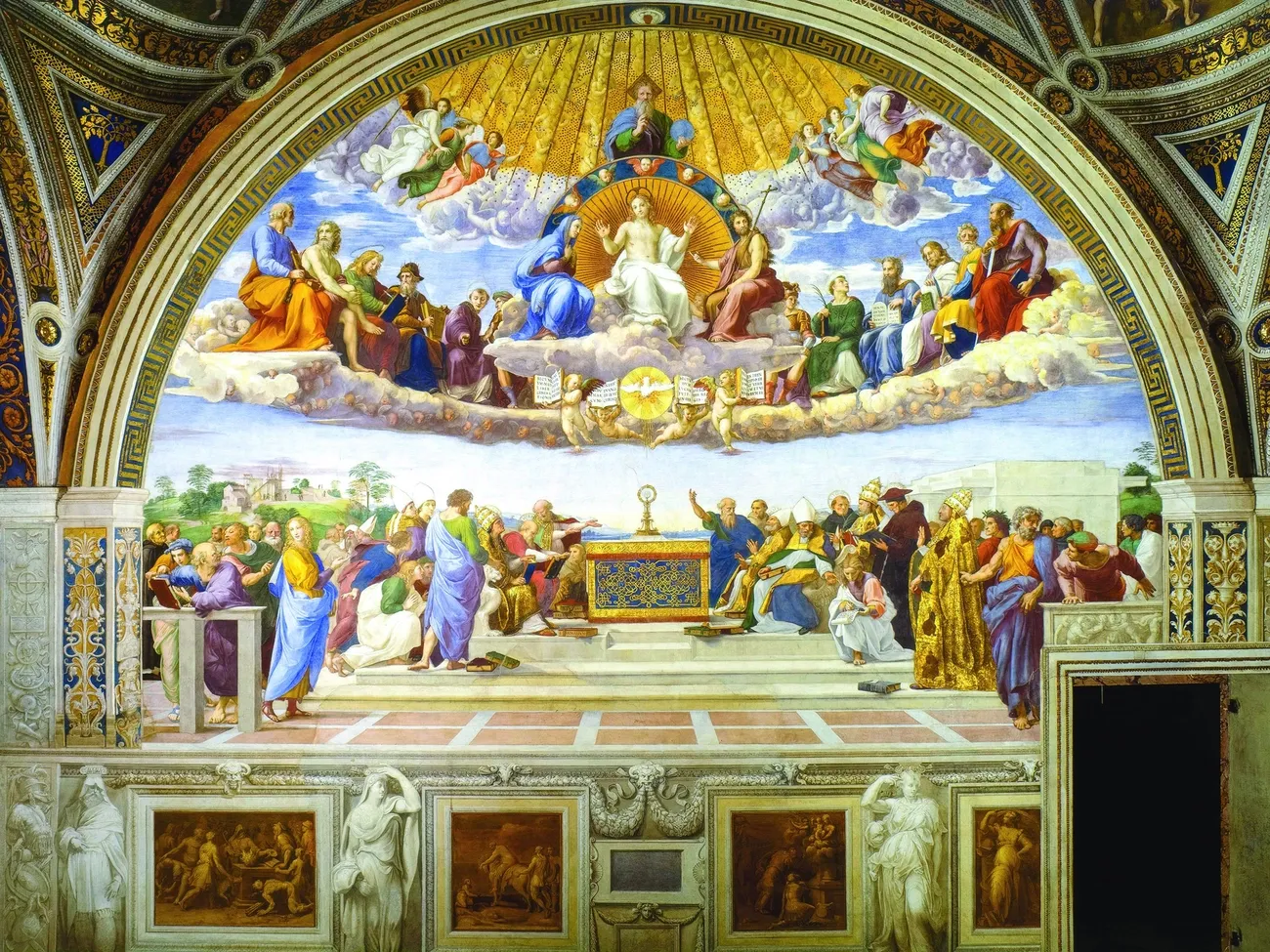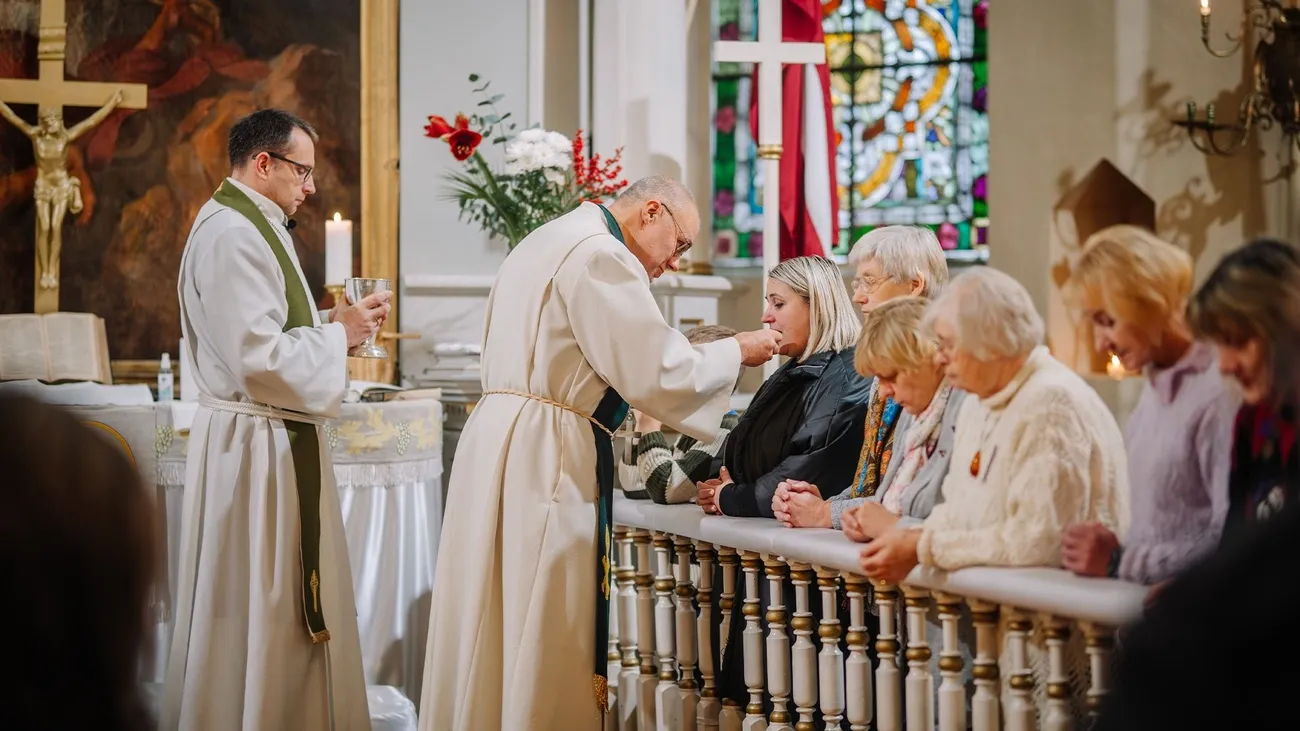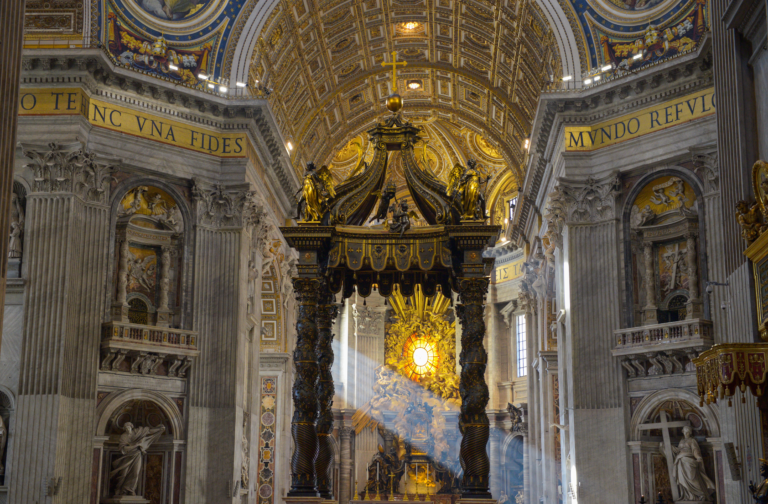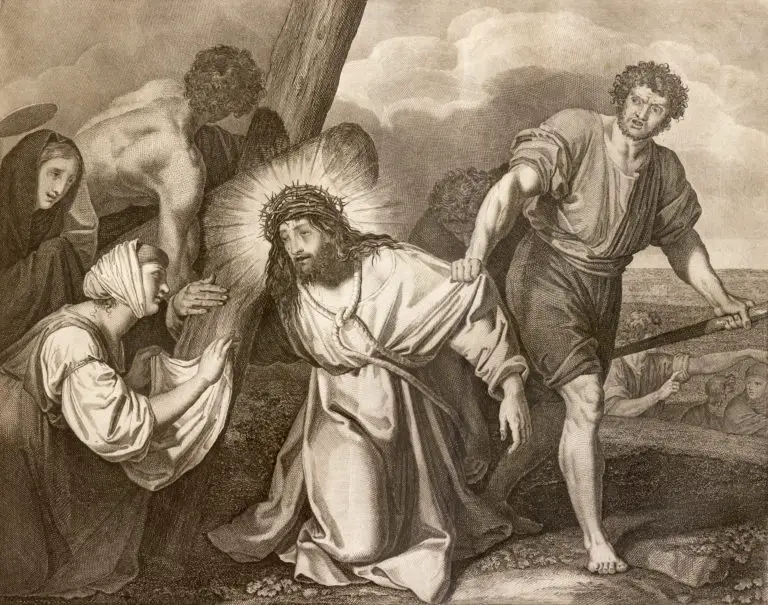What is the Communion of Saints?
The communion of saints is a profound reality that many Catholics recite in the Apostles’ Creed but may not fully comprehend. This doctrine represents a spiritual solidarity binding together the faithful on earth, souls in purgatory, and saints in heaven. The Catholic Church teaches this forms an “organic unity” with Christ as its head. We profess this truth explicitly when we pray, “I believe in… the holy Catholic Church, the communion of saints.”
Throughout Catholic tradition, theologians have understood this communion as encompassing three states of the Church:
The Church Militant (those alive on earth)
The Church Penitent or Suffering (those in purgatory)
The Church Triumphant (those in heaven)
St. Thomas Aquinas teaches that even angels enter this communion because they come under Christ’s power and receive His grace. However, the damned are explicitly excluded from this spiritual family.

To understand how this would take place is to draw upon the mystics, along with Scriptures, to provide a complete picture. The communion of saints is not merely an abstract theological concept—it is a living reality where each member’s spiritual goods benefit others.
As we explore this foundational teaching further, we shall discover how this doctrine connects to St. Paul’s vision of Christians forming a single body in Christ. We shall see why we can pray for one another across the boundaries of life and death, and how this community includes both officially recognized saints and those who have lived virtuous lives in our own communities.
What does ‘communion of saints’ mean?
What does the phrase “communion of saints” truly signify? This beautiful expression appears near the end of the Apostles’ Creed, yet many Christians recite these words without fully comprehending their deep spiritual meaning. The concept carries profound theological significance that extends beyond the boundaries of physical life and death.
I) Origin of the phrase in the Apostles’ Creed
The expression “communion of saints” (Latin: communio sanctorum) was not part of the earliest versions of the Christian creed. Historically, this phrase was added to the Apostles’ Creed around the fifth century, with some of the earliest documented uses appearing in the writings of Saint Nicetas of Remesiana (c. 335–414). Subsequently, the phrase gained wider acceptance, appearing in the Gallican Liturgy of the seventh century and in letters attributed to St. Caesarius of Arles (c. 543).
While the Apostles’ Creed itself is considered “the most universally accepted creed in Western Christendom,” the communion of saints clause developed gradually. This is similar to how the Doctrine of Purgatory and the Doctrine of the Holy Trinity were developed over time. This addition wasn’t the result of formal theological declarations but emerged organically from the devotional practices of early Christians. As believers exercised their faith through veneration of martyrs and holy witnesses, the concept was first practiced devotionally before being formally articulated in the creed.
II)Difference between ‘saints’ and ‘holy things’
The Latin phrase communio sanctorum carries a fascinating dual meaning that enriches our understanding:
Communion among holy persons (sancti) – This refers to the spiritual unity between all believers in Christ, both living and deceased (excluding the damned). As the Catechism explains, “The communion of saints is the Church.”
Communion in holy things (sancta) – This points to the sharing in sacred gifts, primarily the sacraments, especially the Eucharist. As one ancient liturgical proclamation states: “Sancta sanctis!” (“God’s holy gifts for God’s holy people”).
Consequently, the term encompasses both the people who are sanctified and the sacred means through which sanctification occurs. The Catholic Catechism affirms that “the riches of Christ are communicated to all the members, through the sacraments.”
Moreover, this communion isn’t limited to just human believers. St. Thomas Aquinas taught that angels also enter this communion “because they come under Christ’s power and receive of His gratia capitis (capital grace).”
Why this doctrine matters today?
Despite being an ancient theological concept, the communion of saints holds tremendous relevance for contemporary Christian life. This shows the eternal dimension of our faith, reminding us that we are part of something vastly larger than our individual spiritual journeys.
Within the Church, this doctrine fosters a sense of solidarity that counteracts the isolation and individualism prevalent in modern society. The communion of saints provides profound comfort for those facing death. As we read in the Scriptures, during worship we commune not only with God but also with “the assembly of the firstborn who are enrolled in heaven” and “the spirits of the righteous made perfect” (Heb. 12:23). This assurance that our relationships in Christ continue beyond death offers hope amid grief.
To understand how this would take place is to recognize our mutual responsibility within the body of Christ. The Catechism affirms that “in this solidarity with all men, living or dead, which is founded on the communion of saints, the least of our acts done in charity redounds to the profit of all.” This implies that our prayers, good works, and spiritual growth benefit not just ourselves but the entire community of believers across time and space.
The communion of saints ultimately highlights that we belong to a divine family that spans earth and heaven. Much is unknown about the exact mechanisms of this spiritual communion, yet its reality is affirmed throughout the Church’s teaching and tradition.
Are there Biblical Foundations for the Communion of Saints?
Scripture offers profound foundations for the communion of saints, tracing this doctrine through both testaments and establishing its theological roots in God’s revelation. Throughout the Scriptures the notion of communion of saints is implied, even if the exact term is not used.
A)Old and New Testament References
The Bible provides numerous passages pointing to the communion that exists among God’s people across time and space. In the Old Testament, we see early glimpses of this spiritual solidarity when Moses acted as mediator between God and His people (Deut. 5:5). This foreshadowed Christ’s perfect mediation while still allowing for intercession among believers.
The New Testament, however, provides the most explicit foundation for this doctrine. Saint Paul’s letters particularly illuminate this concept through his teaching about Christians forming a single body in Christ. In Romans 12:4-13 and 1 Corinthians 12:12-27, Paul emphasizes that believers constitute one organism with many members, each contributing to the whole.
Paul further develops this theology in Ephesians, writing that Christ is “head over all things to the Church, which is His body, the fullness of Him who fills all in all” (Ephesians 1:23-24). This connection remains unbroken even by death, as Paul affirms in Romans 8:38-39: “Neither death nor life… will be able to separate us from the love of God in Christ Jesus our Lord.”
B) Jesus’ Words and the Mystical Body
The doctrine of the mystical body, central to understanding the communion of saints, originates with Christ Himself. At the Last Supper, Jesus established both the Eucharist and a new covenant in His blood for the entire human race, creating the foundation for this spiritual communion.
Christ’s teaching was then powerfully confirmed at Pentecost. Just as the Holy Spirit descended upon Jesus at His baptism, marking the beginning of His ministry, the Spirit likewise came upon the apostles, visibly demonstrating the supernatural mission of the Church as Christ’s body on earth.
This mystical body concept received further illumination when Jesus made void “the Law with its decrees” and established the New Testament “in His blood shed for the whole human race.” Through His sacrifice, Christ reconciled both Jews and Gentiles, “breaking down the middle wall of partition” that divided peoples, making “the two in Himself into one new man” – namely, the Church.
C) Saints as a ‘Cloud of Witnesses’
Perhaps the most striking biblical image of the communion of saints appears in Hebrews 12:1, which describes believers as “surrounded by so great a cloud of witnesses.” This powerful metaphor reveals that those who have died in faith remain actively engaged with the community of believers on earth.
What does this mean for us as Catholics? It shows us that our spiritual family extends beyond the visible world. The holy men and women who have gone before us are not distant memories but active participants in our spiritual journey.
Hebrews 12:22-23 elaborates that Christians “have come to Mount Zion, and to the city of the living God, the heavenly Jerusalem… and to the spirits of just men made perfect.” This extraordinary passage places living Christians in communion not only with God and angels but specifically with “the spirits of just men made perfect” – a perfect definition of the saints in heaven.
Notably, these witnesses aren’t merely passive spectators. According to Scripture, they’re actively aware of events on earth and invested in our spiritual progress. Jesus Himself taught that heaven rejoices over repentant sinners (Luke 15:7), indicating the saints’ ongoing participation in earthly spiritual affairs.
To understand how this would take place is to draw upon the mystics, along with Scriptures, to provide a complete picture. The biblical foundation for the communion of saints ultimately reminds us that our spiritual family extends beyond the visible world. As Paul wrote to the Colossians, by participating in Christ’s sufferings, we contribute to “what is lacking in Christ’s afflictions for the sake of His body, that is, the Church” (Colossians 1:24) – a mystical reality that unites all believers across the boundaries of time and eternity.
What are the Three States of the Communion of Saints?

1) The Church Militant: Faithful on Earth
The Church Militant encompasses all baptized Christians currently living on earth who are engaged in spiritual battle against sin and evil. This is not about physical violence but refers to our ongoing struggle against “sin, the devil, and the rulers of this world of darkness” as we journey toward salvation.
The term “militant” (from Latin Ecclesia militans) emphasizes that we on earth are active participants in spiritual warfare. As St. Paul writes in Ephesians 6:12:
“Our struggle is not against flesh and blood, but against rulers, authorities, and powers of this dark world.”
We who constitute the Church Militant are pilgrims whose mission is to work for the transformation of the world through the preaching of the Gospel and living virtuous lives. Throughout history, the Church has maintained this identity as an assembly actively confronting spiritual darkness.
2) The Church Suffering: Souls in Purgatory
The second state within the communion of saints is the Church Suffering (Latin: Ecclesia dolens), also called the Church Penitent (Ecclesia poenitens). This comprises souls undergoing purification in purgatory before entering heaven.
What is this state of purification?
The Catholic understanding of purgatory is not a kind of temporary hell but rather the threshold or antechamber of heaven. In this state, souls who died in God’s friendship but still imperfectly purified undergo cleansing. As we read in Revelation 21:27, “nothing unclean shall enter heaven,” necessitating this final purification for many believers.
The suffering experienced is not destructive but transformative—the pain that comes from leaving the old self behind and embracing Christ’s perfection. These souls rely on:
Prayers from the Church Militant
The intercession of saints
The offering of Masses on their behalf
On All Souls’ Day, Catholics specifically remember and pray for these members of the communion of saints.
3) The Church Triumphant: Saints in Heaven
The Church Triumphant (Latin: Ecclesia triumphans) consists of those souls who have reached their goal in heaven and enjoy the beatific vision. They have completed their earthly pilgrimage, undergone any necessary purification, and now rejoice eternally in God’s presence.
The term “triumphant” comes from a Latin word meaning “exulting, rejoicing exceedingly.” These members have definitively triumphed over sin and death through Christ’s victory. They include not only officially canonized saints but all who have entered heaven.
As a result of their perfected state, the Church Triumphant actively participates in the communion of saints by interceding for those still on earth. Our Lord Himself taught that heaven “rejoices over one sinner who repents” (Luke 15:7), showing that saints remain invested in earthly affairs.
This shows the beautiful interconnectedness of the communion of saints—how the three states remain connected in Christ, forming one Church across different dimensions of existence. This unity allows for constant interchange of prayers, merits, and spiritual benefits among all members of Christ’s body.
To understand how this would take place is to draw upon the Church’s tradition, along with Scriptures, to provide a complete picture. The Church Triumphant prays for us, we pray for the Church Suffering, and together we form the one Body of Christ.
I highly recommend studying this doctrine further, as it illuminates our understanding of the Church as a family that extends beyond the boundaries of death itself.
How the Saints Help Us: Intercession and Unity?
The most beautiful aspect of the communion of saints is how those in Heaven actively assist us on our earthly journey. I have often found great comfort in knowing that the saints intercede for us before the throne of God. This spiritual exchange creates a profound bond between the Church Triumphant and those of us still on the pilgrimage of faith.
Why We Ask Saints to Pray for Us?
When we ask the saints for their prayers, we stand on solid theological ground, not superstition. This practice flows naturally from our understanding of the communion of saints. Let us consider why:
The saints have been “made perfect” (Hebrews 12:23) and thus their prayers carry special efficacy. As St. James tells us, “the prayer of a righteous man has great power in its effects” (James 5:16).
We are simply extending the same principle we follow when asking fellow Christians on earth to pray for us. St. Paul himself requested prayers from others (Romans 15:30-32, Ephesians 6:18-20) while assuring them of his prayers in return (2 Thessalonians 1:11).
The objection that we should “go directly to Jesus” misunderstands the communal nature of salvation. Of course we should pray directly to Christ! Yet this doesn’t negate the value of additional prayers. Throughout the Scriptures, we see Jesus regularly responding to one person based on another’s faith (Matthew 8:13, 15:28).
What is the Role of Angels and Saints in Heaven?
The saints in Heaven are not distant observers but active participants in our spiritual journey. They remain connected to us through Christ’s mystical body and maintain awareness of earthly events. As we read in the Scriptures, Revelation 6:9-10 shows departed souls aware of happenings on earth, while Hebrews 12:1 describes them as “a great cloud of witnesses” surrounding us.
Together with angels, saints present our prayers to God. This is beautifully illustrated in Revelation 5:8, which depicts the twenty-four elders (representing saints in heaven) holding “golden bowls full of incense, which are the prayers of the saints.” Similarly, Revelation 8:3-4 shows an angel offering incense with “the prayers of all the saints” upon the golden altar before God’s throne.
This intercessory ministry does not diminish Christ’s unique mediatorship. Rather, it shows how Christ incorporates others into His saving work. Just as we accept help from other members of Christ’s body on earth, we should welcome assistance from those perfected in heaven (1 Corinthians 12:20-21).
Examples from Scripture and Tradition
The Scriptures provide numerous examples of heavenly intercession:
During the Transfiguration, Jesus spoke with Moses and Elijah (Matthew 17:1-4), demonstrating communion between the living and departed saints.
In Jeremiah 15:1, God Himself references how Moses and Samuel stand before Him, interceding for Israel.
The rich man in Jesus’ parable (Luke 16:19-31) addresses Abraham in heaven with a petition.
In 2 Maccabees 15:12-16, the deceased high priest Onias and prophet Jeremiah are shown praying for the Jewish people.
Throughout Church history, this intercessory relationship has been acknowledged in liturgical practice. St. John Chrysostom wrote that during Mass, “the whole sanctuary and the space around the altar are filled with heavenly powers to honor the One who is present on the altar.”
I highly recommend deepening your understanding of this beautiful aspect of our faith. The saints’ intercession reflects the perfect love they now possess in heaven. Having attained the beatific vision, they love with undivided hearts, participating fully in Christ’s ongoing work of salvation for their brothers and sisters still journeying on earth.
The Communion of Saints – Our Spiritual Family Beyond Death
Sharing Spiritual Goods in the Body of Christ

What does it mean to share in spiritual goods?
The communion of saints facilitates a divine exchange where Christ’s grace flows freely among all members. This spiritual sharing enriches the entire Body of Christ through a profound interconnectedness established by God Himself.
The Treasury of Merits – A Spiritual Storehouse
The treasury of merits represents the superabundant store of righteousness belonging to Christ, Mary, and the saints. In Catholic understanding, this treasury contains “the infinite value, which can never be exhausted, which Christ’s merits have before God.” These merits were offered so that mankind could be set free from sin and attain communion with the Father.
This treasury, however, is not limited to Christ’s merit alone. It includes:
The prayers and good works of the Blessed Virgin Mary
The merits of all the saints who have followed in Christ’s footsteps
The spiritual riches accumulated throughout the Church’s history
St. Thomas Aquinas teaches that these combined spiritual riches create what the Church traditionally calls the “treasury of merit.” This shows the extent that God has extended His hand of Mercy to all His children.
How Sacraments and Prayers Benefit All?
The spiritual goods of the communion of saints are distributed primarily through sacraments and prayer. The Eucharist particularly reveals this reality, for as we participate in the sacrifice, “we too are offered to the Father in union with Our Lord.”
As Catholics, we believe in the efficacy of prayers offered within the communion of saints. Just as the early church demonstrated in Acts, believers form a partnership of prayer that strengthens the entire community. When we pray for one another, we participate in this divine economy of grace.
Throughout the Scriptures the notion of shared spiritual benefits is implied. St. Paul writes in 1 Corinthians 12:26, “If one member suffers, all suffer together; if one member is honored, all rejoice together.” This is consistent with the Catholic understanding that our prayers and spiritual goods benefit not only ourselves but the entire communion.
Charity and Good Works in the Communion
Charity and good works vitally contribute to this spiritual treasury. As St. James reminds us, “faith without works is dead” (James 2:26), demonstrating how our actions enrich the communion of saints.
The following acts of charity especially contribute to this spiritual economy:
Works of mercy
Almsgiving
Prayer for others
Acts of penance and self-denial
Our personal commitment to conform our lives to the pattern of Christ’s life creates communion with God and all humanity. This is ratified in the teachings of the Church Fathers and in numerous Church councils.
I highly recommend exploring the writings of the Church Fathers on this topic, particularly St. Augustine’s reflections on the unity of the Body of Christ. A great read that illumines the mind and gives great insight into how our spiritual goods benefit others in the communion of saints.
In participating in this divine economy, we produce great benefits not only for ourselves but for others throughout the communion of saints. This is the beauty of our Catholic faith – that none of us journeys alone, but rather we are supported by and supporting others in a vast spiritual family.
Who belongs to the Communion of Saints?
The Communion of Saints is not simply a collection of all who call themselves Christian. Rather, it is a divine fellowship of souls bound together through grace and the sacramental life. But who can be saved? Who truly belongs to this spiritual family?
Baptism: The Gateway to this Communion
Baptism serves as the fundamental entrance into the Communion of Saints. Through this sacred sacrament, we are incorporated into Christ’s mystical body, establishing a profound spiritual bond with all other baptized believers. The Catechism teaches this explicitly: “After confessing ‘the holy catholic Church,’ the Apostles’ Creed adds ‘the communion of saints.’ In a certain sense this article is a further explanation of the preceding: ‘What is the Church if not the assembly of all the saints?'”
As long as we remain within the Church receiving sacraments and striving to live the Faith, we participate in this communion. The effects of Baptism include:
Forgiveness of original sin and personal sins
Birth into new life as adopted children of God
Incorporation into the Church, the Body of Christ
Participation in the priesthood of Christ
Grace: The Lifeblood of this Communion
What keeps this communion vibrant and alive? Grace operates as the essential lifeblood of this spiritual communion, flowing in two primary ways:
Externally, through sacraments—particularly the Eucharist, where Christ “spiritually causes a ‘fusion of experiences'” as He penetrates the soul
Internally, through our pursuit of virtue and spiritual growth
Throughout this process, Christ remains the head of the body to which we belong. As Catholics, we “remember that they are members one of another, and above all, members of Christ.”
The Excluded: Those Outside the Communion
Not everyone participates in the Communion of Saints. The Catechism clearly states that “the damned are thus excluded from the communion of saints.” This is problematic for many non-Catholics, yet it follows from the nature of this communion as a union with Christ.
Additionally, those who deliberately separate themselves through serious sin diminish their participation in this spiritual community. While excommunicated persons technically remain Catholic (since Christian baptism imprints an “indelible character on the soul”), they are “deprived of the benefits of full communion with the Catholic Church.”
Much is unknown about the precise boundaries of this communion, as God’s mercy extends beyond our understanding. Yet tradition teaches that even the wicked within the Church are merely “carried along” in this communion without actively contributing to its spiritual vitality.
I highly recommend reflecting on your own participation in this communion. Are you actively receiving the sacraments? Are you striving to grow in virtue? These questions help us appreciate our place within the divine family that is the Communion of Saints.
Conclusion – Our Eternal Spiritual Family
The communion of saints is not merely a theological concept but a living reality that connects us across the boundaries of life and death. Throughout this exploration, we have seen how this spiritual family transcends physical limitations, uniting believers across time and space in Christ’s mystical body.
Our membership in this divine communion begins with the sacrament of Baptism and grows through grace, prayer, and participation in the sacraments. The spiritual goods we share—prayers, merits, and intercessions—benefit every member of Christ’s body. Even our smallest acts of charity ripple throughout this divine community.
The three states of the Church—Militant, Suffering, and Triumphant—reveal our changing relationship with God while maintaining our essential unity in Christ. Death changes but never severs our connection to fellow believers. Those who have gone before us now intercede from a position of perfected love.
Throughout the Scriptures, this truth is confirmed. From St. Paul’s teaching about the Body of Christ to the “cloud of witnesses” described in Hebrews, biblical evidence supports this ancient understanding. The early Church Fathers developed this understanding, and it has been part of the deposit of faith since the beginning of Christianity.
I highly recommend reflecting on this beautiful doctrine whenever you recite the Apostles’ Creed. Pause at the phrase “communion of saints” and consider what it truly means—you belong to a spiritual family that spans heaven and earth, united forever in Christ.
This shows the extent that God has extended His hand of Mercy, creating not just individual salvation but a community of love that transcends even death itself. As Catholics, we believe in this spiritual solidarity that binds us together with all the faithful—past, present, and future.
Praise God for His Mercy and Love that has given us this communion with each other and with Him.
FAQs
Q1. What exactly is the communion of saints? The communion of saints refers to the spiritual unity between all believers in Christ, both living and deceased. It encompasses the Church Militant (faithful on earth), Church Suffering (souls in purgatory), and Church Triumphant (saints in heaven), all connected as members of Christ’s mystical body.
Q2. How do saints in heaven help those on earth? Saints in heaven actively participate in the spiritual lives of those on earth through intercession. They present our prayers to God and offer their own prayers on our behalf. This doesn’t replace Christ’s role as mediator but demonstrates how He incorporates others into His saving work.
Q3. Who is included in the communion of saints? The communion of saints primarily includes baptized Christians who remain in a state of grace and unity with Christ. It encompasses believers on earth, souls in purgatory, and saints in heaven. Those who have deliberately separated themselves through serious sin or are damned are excluded from this spiritual communion.
Q4. What is the “treasury of merits” in Catholic teaching? The treasury of merits is a spiritual concept referring to the abundant store of righteousness belonging to Christ, Mary, and the saints. It includes Christ’s infinite merits and the prayers and good works of all the saints. This treasury is distributed to believers through sacraments, prayers, and acts of charity.
Q5. How does the communion of saints benefit believers today? The communion of saints provides spiritual support, comfort, and inspiration to believers. It reminds us that our faith journey is not solitary but connected to a vast spiritual family. Through this communion, our prayers, good works, and spiritual growth benefit not just ourselves but the entire community of believers across time and space.






